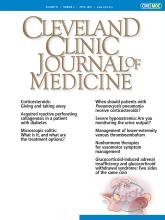Article Figures & Data
Tables
Test Results Reference range Sodium 109 mmol/L 136–144 Potassium 3.4 mmol/L 3.7–5.1 Blood urea nitrogen 18 mg/dL 7–21 Creatinine 0.9 mg/dL 0.58–0.96 Estimated glomerular filtration rate 87 mL/min/1.73 m2 ≥ 60 Carbon dioxide 23 mmol/L 22–30 Chloride 79 mmol/L 97–105 Glucose 75 mg/dL 74–99 Albumin 3.1 g/dL 3.9–4.9 Calcium 8 mg/dL 8.5–10.2 Aspartate transaminase 118 U/L 14–40 Alanine transaminase 68 U/L 10–54 Lactate 0.8 mmol/L 0.5–2.2 Test Results Reference range Blood osmolality 237 mOsm/kg 275–300 Urine osmolality 95 mOsm/kg 50–1,200 Urine sodium 22 mmol/L 14–216 - TABLE 3
Causes of hyponatremia and their usual corresponding urine studies and urine output
Volume status Etiology Urine osmolality Urine sodium ADH-dependent Urine output Hypovolemic Volume loss (nonrenal) > 100 mOsm/Kg < 30 mmol/L Yes Decreased Cerebral salt wasting > 100 mOsm/Kg > 30 mmol/L Yes Increased Diuretics > 100 mOsm/Kg > 30 mmol/L Yes Increased Euvolemic Syndrome of inappropriate ADH > 100 mOsm/Kg > 30 mmol/L Yes Decreased Low-solute state < 100 mOsm/Kga < 30 mmol/L No Variable Primary polydipsia < 100 mOsm/Kg Variable No Increased Reset osmostat Variable Variable No Variable Hypervolemic Cirrhosis > 100 mOsm/Kg < 30 mmol/L Yes Decreased Heart failure > 100 mOsm/Kg < 30 mmol/L Yes Decreased Kidney failure > 100 mOsm/Kg > 30 mmol/L No Decreased ↵a The osmolality in a low-solute state can be higher in a concomitant hypovolemic state.
ADH = antidiuretic hormone






